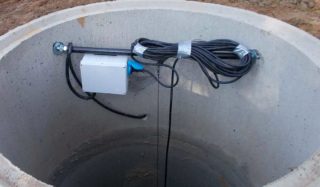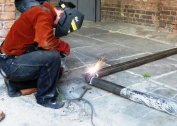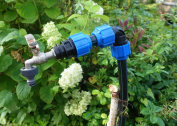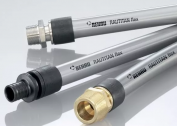To create a reliable water supply system in the country, you must first make a well with your own hands or hire specialists. Before using water from such a source, it is important to ensure its quality. And then draw up a detailed project of the future water supply system, make sure that you have the necessary tools and proceed with the task without haste.
Features of the supply of cottages with water from the well
The well system has many advantages against a small number of disadvantages:
- the possibility of using a large diameter shaft for installing submersible pumps;
- the availability of manual lifting of water in the absence of electricity;
- minimum rate of formation of sludge and sanding with the correct structure of the well;
- the possibility of self-cleaning the well as opposed to the need to call specialists to service the well;
- the possibility of self-preservation of the system;
- minimum amount of salts and iron in the water from the well.
However, well water can be contaminated with feces, fertilizers, rot molecules, bacteria, so it is forbidden to refuse to use the filter.
Summer and winter water supply from the well
When organizing a water supply system from a well, it is important to consider in what conditions the water supply will be used. For the winter system, the mandatory requirements will be:
- laying with a slope towards the well under the level of freezing of the earth;
- use of thermal insulation for a well and pipes;
- application of a water heating cable along a water supply system.
Summer schemes do not require such strict attention. You can install pipes directly on the ground or in a small depression. Flexible hoses can be used, which after the summer season are dismantled and stored in the pantry whether underground.
Country Water Supply Project
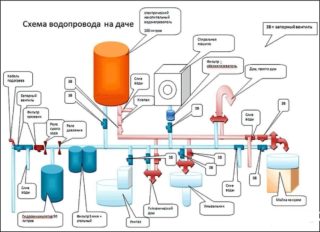 Planning a water supply scheme from a well in a country house is the only way to do everything right, to avoid unnecessary time and financial costs. It is necessary to draw up a plan of the site with the designation of the house, garden, bath, cesspool or septic tank. Also, the position of the water supply system, including the points of the taps and the draw-off, is noted on the plan.
Planning a water supply scheme from a well in a country house is the only way to do everything right, to avoid unnecessary time and financial costs. It is necessary to draw up a plan of the site with the designation of the house, garden, bath, cesspool or septic tank. Also, the position of the water supply system, including the points of the taps and the draw-off, is noted on the plan.
To determine all the points you need to go through the site, measuring all the important elements with a tape measure. Using this approach, the position of adapters, couplings, and fittings can be accurately indicated.
Consumption points consist of the following elements:
- outside the house - installation of hydrants for irrigation;
- inside the house - the use of a hydraulic accumulator and plumbing;
- individual elements - taps in the bathhouse, summer kitchen.
It is best to choose places for the ground system that correspond to the position of paths, ditches, fences. If underground work is planned, they must be calculated together with the specialists who will carry it out.
When planning, it is important to determine how deep the trenches will be. For a summer water supply, on a flat section, the depth reaches 40 cm, and on an uneven one, up to 80 cm. A winter water supply can occur at a depth of 2-3 m or more.
Also on the plan should be a general drainage point, necessary for the water supply conservation procedure. It should be freely available. Preservation is carried out for the winter. After drawing up the plan, you can proceed to purchase the missing tools, equipment, as well as consumables.
Tools, equipment and materials for installation
When the well is already dug up and equipped, you need to pick up accessories for the country water supply.The first necessary element is a pump:
- surface - used if the depth of the well does not exceed 10 m;
- submersible - can be used in deep sources, it is fixed at the bottom of the well;
- pumping stations - are installed where both watering the garden and equipping the house are required, are mounted indoors or in protected caissons.
When choosing, it is important to consider the distance of the well from home.
Thermal insulation for pipes
Insulating materials are needed in the construction of a winter water supply system. For this, the following shell segments are used:
- from mineral wool;
- from foam;
- from polyurethane foam.
You can install insulation with your own hands. Its additional advantage is protection against mechanical damage.
Pipes and fittings
For the installation of water from the well in the country, pipes with a diameter of 32 mm are used. They can be metal-plastic, plastic and metal. The first two options are better suited, as they are easier to handle, more reliable, do not freeze and do not lend themselves to corrosion.
Also required are fittings, connectors, gate valves, brackets, taps, strainers, mixers. From the tools you need to prepare the grinder, punch, gas key.
System Installation Steps
 After preparing the necessary tools and elements, you can proceed to bring water from the well to the house in the country with your own hands:
After preparing the necessary tools and elements, you can proceed to bring water from the well to the house in the country with your own hands:
- Install pumping equipment. If it is an immersion system, it is lowered to the bottom, following the instructions, if stationary, put in the utility room.
- Installation of a water intake pipe. They dig a trench, focusing on the type of water supply. At the same stage, using a punch, make a hole in the well pipe.
- Installation of pipes. Before laying the system, each pipe is “dressed” in the thermal insulation selected at the planning and purchase stage of the elements.
- Connection pipe to the well. A hole is made in the well shaft and the pipe is lowered into it almost to the bottom, leaving a distance of 25-35 cm to it. Water at this stage must be completely removed from the well.
- Pipe fastening at the bottom. A pin is installed in the well to which a water intake pipe is mounted, after installing a strainer on it. Next, close the inlet in the well using sealant or tile adhesive.
- Close up of the trench. After laying the intake pipe, a trench is filled up. At the same stage, a water heating cable is laid if it is used.
- Installation of a pumping station. They connect the pipes to the station, put a coarse filter and a valve in front of the inlet, and a fine filter, pressure switch and pressure gauge at the outlet.
The next stage requires dilution of the water supply at the points of fluid intake. Using a grinder, they cut pipes, connect fittings and seals, install crimp rings with nuts on the points.
All pipes are laid at an angle relative to the place of water discharge. Therefore, installation begins from the bottom up - from the lowest to the highest point on the site.
Possible errors and their correction
Most often, malfunctions occur during the construction of a water supply from an existing well. It is best to make a source right away with laying pipes.
Another mistake is construction at the wrong time of the year. It is better to conduct it in spring or summer, when the water level is at a minimum mark, and the soil has not yet taken up a layer of permafrost.
Despite the high cost of the accumulator, its use is mandatory. This is the only way to improve the quality of system maintenance and avoid any malfunctions in the future.
